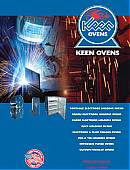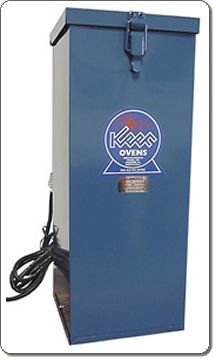Industrial Ovens
Front-Loading
![]() Under 10 cubic feet
Under 10 cubic feet
![]() 10-20 cubic feet
10-20 cubic feet
![]() Over 20 cubic feet
Over 20 cubic feet
![]() See All
See All
Top-Loading
![]() Under 10 cubic feet
Under 10 cubic feet
![]() 10-20 cubic feet
10-20 cubic feet
![]() Over 20 cubic feet
Over 20 cubic feet
![]() See All
See All
Learn About Our Industrial Ovens
Welding Ovens
![]() CONEX Storage
CONEX Storage
![]() Stick Electrodes
Stick Electrodes
![]() Sub-Arc Flux
Sub-Arc Flux
![]() Wire Spools
Wire Spools
![]() Tig Filler Wire
Tig Filler Wire
![]() Multi-Purpose
Multi-Purpose
![]() Nitrogen Purge
Nitrogen Purge
![]() See All
See All
 Order Our Free Catalog Today Click Here |
| Available Inventory |
Welding Rod Storage 101:An Old Refrigerator with a Light Bulb is not a Rod Oven
On some pre-cast parking garages we used 5/32" to weld double tee connections, (the long floor spans that look like two upside down T's) but still 7018, just a different diameter, and like 1/8" they needed to be kept in a rod oven to keep the moisture out of them. Click here to view our welding ovens and to learn about the benefits of proper storage! We used the 5/32" rods because they deposited more metal and seeing as how most of the connections we welded were in the flat position, it made sense. Most of the time though, I was welding on all steel structures and we used 1/8". And by the way, in case you're wondering, the pre-cast concrete structural members had steel plates in them that matched up so we could weld on them.
I've seen some crazy improvised rod ovens in my day both in shops, and in the field. Funny how in some cases it would've been easier to buy a dang oven in the first place after adding time wasted, and materials used on some of those hair-brained ideas. The most common rod oven we made had to do with the good ol' refrigerator. The refrigerator is probably the most common used/abused rod oven myth out there. There's the incorrect belief that it works on low-hydrogen rods for keeping moisture out, and there's even a myth about wrapping rods in plastic and storing them in the freezer! What happens is people disconnect the cooling system and run a light bulb in it to produce heat. The problem is rod ovens need to be at least 250 to 450 degrees F to keep boxes in, 150 -200 degrees F to store bare rods in, and - 500, that's right FIVE HUNDRED, to 600 degrees to re-heat rods that have been exposed to the atmosphere. I don't know of too many light bulbs that are going to keep those temperatures inside a refrigerator. Heck, you can get a small portable oven for about $150, and a larger one for a couple of hundred (See Keen Ovens.) Like I said in the article in the article on 7018 rod storage, don't feel bad at all if you've done this, you're sure not alone! I've done it myself before I knew better and I've see 'em on a bunch of different jobs for some really big companies, including a huge coal-fired power house! That's how far the myth has spread. I think the worst refrigerator, slash, rod
oven I ever saw was one that had previously been used to store fish. Once that
light bulb started heating that sucker up, it was every man for himself getting
out of that shop! |
 There
are a lot of myths out there about storing welding rods, especially in make-shift
rod ovens. Out on structural jobs we used primarily 1/8" 7018 low-hydrogen
rods and they needed to be kept dry. (see
There
are a lot of myths out there about storing welding rods, especially in make-shift
rod ovens. Out on structural jobs we used primarily 1/8" 7018 low-hydrogen
rods and they needed to be kept dry. (see